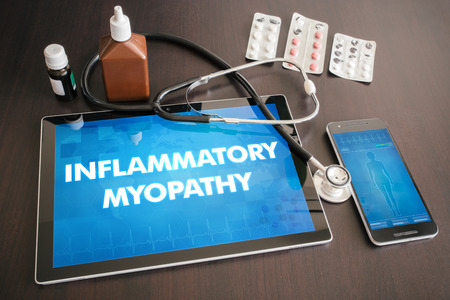Myopathy Definition
Myopathy is defined as a disorder that affects the muscle itself. The muscle is made of fibres that contract in a rhythmic fashion resulting in contraction of the muscle and movement of that part.
Here the muscle fibres that make up the muscle mass are affected and cause lies within the muscle itself. In many other conditions, the cause of the muscle weakness is neurological in origin where the nerve supply is affected leading to muscular problems. Weakness, muscle cramps and stiffness of the affected muscle are some of the common manifestations of myopathy.

Causes and Symptoms of Myopathies
There are many known causes of myopathies and they all affect the skeletal muscles of the body. These causes include genetic, inflammatory, metabolic and hormonal disorders. We shall discuss the list of muscular system diseases and their causes along with symptomatology.
(1) Genetic Myopathy:
The cells within the muscles are responsible for producing proteins of many types and this production is under the control of genes. When there is a genetic defect, the particular protein production is affected. It is either deficit or made in excess leading to myopathy. Examples of genetic muscle disorders are:
- Central core disease
- Myotubular myopathy
- Periodic paralysis
- Mitochondrial muscular myopathy
Most of the genetic disorders have an autosomal dominant inheritance where one defective gene is sufficient for the transmission of the disease. One of the parent has a defective gene and so he manifests the active disease. Each of his children have a 50% chance of getting the disease. This probability remains the same in male and female children.
In case of myopathies, two defective genes need to be inherited one from each parent to get the disease. This is also called as autosomal recessive pattern of inheritance.
Symptoms:
- Weakness of the voluntary muscles leading to difficulty in walking and climbing stairs. In children it can lead to delayed motor skills and milestones like sitting up, crawling and walking. When the child grows up, he is unable to jump, run and climb stairs like other children due to muscle weakness fatigue.
- Among other causes of pain in legs and thighs, myopathy is one of them.
- Another condition that may be associated with myopathy is myotonia where the muscle contracts normally but it fails to relax leading to stiffness and fatigue. This happens mostly after exposure to cold and long periods of rest like a night’s sleep. Jerking and repeated movement helps the muscle to get back to normal.
- The muscles may have periodic moments of weakness and paralysis. This paralysis is a result of the potassium levels fluctuating in the blood as in hypokalemia or hyperkalemia.
- In mitochondrial myopathy, the symptoms are slightly different. The muscles of the eye are affected called as ocular myopathy. There is weakness of the arms and legs and there can be multisystem problems involving the brain.
(2) Inflammatory Myopathy:
There are some disorders which lead to an inflammatory reaction within the muscles and cause myopathy. They are associated with the typical signs of inflammation like heat of the part, redness, inflammation, swelling and pain. Examples of this type of muscle diseases are:
- Dermatomyositis is a disorder of the connective tissue involving the muscles. The exact cause is not known but it holds some relation with rheumatological diseases and cancer.
- Polymyositis is an inflammatory disorder involving more than one muscle groups. It is associated with pain, deformity, swelling and sleep problems.
- Myositis ossificans is a rare genetic condition where the muscle tissue gets replaced by bone tissue. It begins in childhood and is a cause of muscle disorders in children.
(3) Endocrinal Myopathy:
The myopathy symptoms arise as a result of some endocrine causes where the production of hormones is abnormal. In hyperthyroidism, the levels of thyroxine are very high and so there is muscle weakness, wasting of muscles associated with tremors and weight loss. In hypothyroid myopathy, there is deficiency of the hormone leading to muscle weakness, cramps and stiffness.
(4) Muscular Dystrophy:
Muscular dystrophy is a disease that affects the muscle groups leading to progressive loss of muscle mass and loss of strength to carry out day to day activities. There is a lot of muscle pain and weakness. The main reason is the lack of protein called dystrophin within the muscle. This disturbance in protein synthesis is genetic in origin. The condition is more common in males and it is seen in young age and adolescence.
Diagnosis
Each case of myopathy needs to be investigated in detail. It begins with history taking. Appearance of symptoms and their severity and intensity are recorded. To confirm the diagnosis, laboratory investigations are used.
(a) History: The following points are noted while taking the history of the patient
- Presence of family history of periodic paralysis or muscular dystrophy
- History of pre-existing autoimmune disease, thyroid problems or renal insufficiency
- History of severe weakness-weak legs or painful legs experienced after exposure to cold or post a heavy meal
- History of electrolyte imbalances
- Use of medications like steroids, lipid lowering drugs or alcohol consumption
- Travel history to rule out the consumption of barium chloride accidentally.
(b) Investigations:
- Creatine kinase is present within the muscles and gets elevated if there is a muscle injury.
- Serum myoglobin levels
- Serum blood urea nitrogen and Serum creatinine
- Complete blood count
- ESR-erythrocyte sedimentation rate
- Thyroid function tests
- Calcium, magnesium and potassium levels.
- Urine analysis shows myoglobinuria and red blood cells on microscopic study
Other investigations include imaging techniques and special tests:
- Genetic testing
- Electromyography
- Magnetic resonance imaging (MRI)
- Muscle biopsy
- Antinuclear antibody levels
- ECG – Electrocardiography

Management of Myopathy
The treatment of the myopathy mainly depends on the causative factor. Supportive therapy may be required for cases that present with acute symptoms like maintaining the breathing, airway, circulation and hydration of the patient. The treatment will change as per the existing cause.
- Periodic paralysis caused by fluctuations in the potassium levels can be treated by diet and medication
- For myopathy resulting out of endocrinal imbalances like hypo or hyperthyroidism, hormonal replacement or medications need to be given to stabilize the levels of thyroxine in the blood.
- Myopathy that is part of central core disease or nemaline myopathy have no known treatment methods.
- Myositis ossificans where the bone tissue replaces the muscles is untreatable and the patient can only be given symptomatic relief.
- Muscular dystrophy is another progressive debilitating disorder. Gene therapy is being tried to control the symptoms of the disease.
- Physical therapy aims at helping the person carry out his daily activities without help. They work by strengthening the muscles and increasing muscle strength.
- Occupational therapy is usually needed by those individuals who have muscle weakness or a particular part and it is hindering their work. They will be taught the use of braces and alternate methods to function inspite of the minor disability.
- For speech and language disorders, a speech pathologist needs to be consulted. The various methods and techniques used by them to strengthen the muscles of the tongue and mouth help the patient to a great extent.


